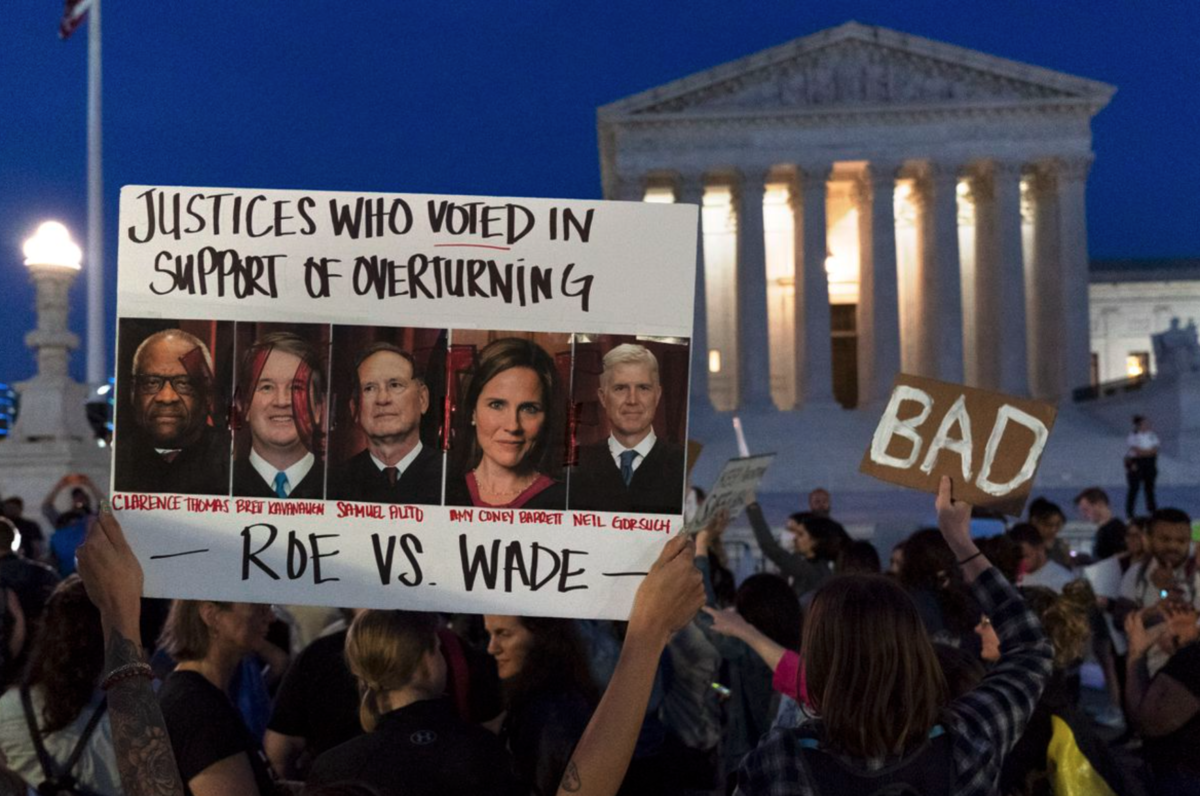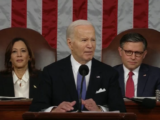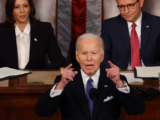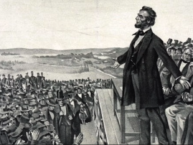The Big Picture –
By Glynn Wilson –
Something in the tumblers of the universe just shifted, and at least here in the United States, shockwaves began moving across the landscape between the waning hours of Thursday, June 23, and hit the land hard on Friday afternoon and Saturday, June 24-25, 2022.
Days that will live in infamy.
Much like those insects that went crazy in the campground last summer when the cicadas came out of the ground for the first time in 17 years, people seemed to go a little bonkers here. I almost thought I was going to be forced to get law enforcement involved for real.
Saturday night ended quietly, however, so I finally turned back to join those nine or so percent of Americans who actually watched the fifth hearing of the House Select Committee investigating the Capitol attack, me on C-SPAN, along with the millions catching clips on cable TV and social media. We saw in detail what we already knew about Trump: A president so corrupt that he would literally try to turn the United States Department of Justice into a legal arm of his coup attempt – and it came horrendously close to succeeding.
While Trump is not the first U.S. president to abuse the Justice Department and system for political purposes, his case is by far the worst in American history. He should not be allowed anywhere near the Oval Office again after pulling this corrupt, illegal and unconstitutional horseshit.
But we should remember that both Bush’s abused the justice system, as did Reagan. Nixon tried it, but it blew up in his face.
Even Democrats like Clinton also dabbled in it, as did Johnson and Kennedy. And FDR packed the Supreme Court.
Of course I wrote a lot about this abuse of justice during the administration of George W. Bush. Long-time readers will recall the case of Alabama’s last Democratic Governor Don Siegelman railroaded out of the governor’s office and into prison. I also wrote about an episode during the Reagan administration in the 1980s about the racial and partisan difference between how the Reagan Justice Department treated Birmingham Mayor Richard Arrington and upstart Republican accident, Amway salesman, chicken farmer and primitive Baptist preacher Guy Hunt.
That reporting was cited by name in a book by former New York Times reporter David Burnham back in 1996, which I reviewed for The Macon Telegraph.
House Select Committee Showed How Trump Tried to Manipulate Justice to Hold Power
As reported by The New York Times and other media outlets on Thursday for Friday, however, the House committee investigating the Jan. 6 attack on the Capitol painted a vivid picture on Thursday of how former President Donald Trump directed a wide-ranging bid to strong-arm his Justice Department into overturning the 2020 election, “the most brazen attempt by a sitting president since Watergate to manipulate the nation’s law enforcement apparatus to keep himself in power.”
In a well thought out and meticulously gathered exhibit of evidence, including testimony from top officials who resisted Trump’s scheming, the committee laid out how Trump tried repeatedly to use the department to interfere in the election. In near-daily conversations, he badgered its leaders to act on unsubstantiated claims of election fraud, including wild internet hoaxes, accusing them of failing to do their jobs. He explored naming a conspiracy theorist who was circulating outlandish stories of voting irregularities to serve as a special counsel to look into possible election malfeasance that did not exist.
“Why don’t you guys just seize machines?” Trump demanded at one point, later calling a top official at the Department of Homeland Security when someone told him voting machines fell under that agency’s jurisdiction, not DOJ.
When top department officials repeatedly told him that they had investigated and debunked his allegations of widespread election fraud, Trump said they just needed to “find” the damn evidence for him.
“Just say the election is corrupt and leave the rest to me,” he told them, according to sworn testimony played for all to see on Thursday.
When officials refused to go along, Trump embraced a plan to remove the acting attorney general and install a loyal toady, Jeffrey Clark, to do his bidding. During a heated showdown in the Oval Office, only the threat of a mass resignation at the department persuaded Trump to back down.
With testimony and new documents, the committee painted a picture of an “embattled” Justice Department that worked frantically to stave off a constitutional crisis driven by a president who refused to relinquish his power, and showed how close the country actually came to a total legal and constitutional breakdown.
“He pressured the Justice Department to act as an arm of his re-election campaign,” Committee Chair Bennie Thompson, the Mississippi Democrat, summarized the evidence against Trump. “He hoped law enforcement officials would give the appearance of legitimacy to his lies, so he and his allies had some veneer of credibility when they told the country that the election was stolen.”
Just three days before the Jan. 6 insurrection, White House call logs show Clark was referred to as the acting attorney general, suggesting that parts of the White House already believed that Trump had gone through with his plan and ousted Rosen, his named acting attorney general — unconfirmed by the Senate — after William Barr resigned in December.
Rosen testified that he attended a meeting at the Oval Office later that afternoon in efforts to save his job and stave off a “calamity that would have engulfed the nation.”
“I wanted to try to convince the president not to go down the wrong path that Clark seemed to be advocating,” Rosen said. “I did not want for the Justice Department to be put in a posture where it would be doing things that were not consistent with the truth or not consistent with its own appropriate role or were not consistent with the Constitution.”
But Trump appeared unmoved by the implications of what he was asking.
“What do I have to lose?” he asked the top department officials, according to testimony from Richard P. Donoghue, acting deputy attorney general at the time.
The panel also presented evidence that after the Jan. 6 attack, at least six Republican members of the House who played leading roles in Trump’s efforts to use Congress to overturn the election sought pardons for themselves and for all the Republicans who voted to reject electoral votes for Biden. The list, according to the testimony of Cassidy Hutchinson, an aide to Trump’s White House Chief of Staff Mark Meadows, included Matt Gaetz of Florida, Mo Brooks of Alabama, Andy Biggs of Arizona, Scott Perry of Pennsylvania, Louie Gohmert of Texas and Marjorie Taylor Greene of Georgia.
Biggs, Perry and Gohmert denied that they had ever sought pardons for themselves. Greene called the testimony about her “gossip and lies.”
Brooks, who just lost in his Republican primary runoff bid to replace Richard Shelby in the U.S. Senate, acknowledged that he had sought pardons for more than 100 Republicans in Congress after the violence of Jan. 6, but said he did so because he was concerned that the “Democrats would abuse the judicial system by prosecuting and jailing Republicans who acted pursuant to their constitutional or statutory duties.”
Clearly he doesn’t understand the law or the Constitution any better than Trump.
Gaetz did not immediately respond to a request for comment from the Times. He faces a mountain of legal troubles of his own.
While these House members were not all directly tied to the pressure on the Justice Department, the committee shed more light on the prominent role Perry played in Trump’s effort to “weaponize” or politicize the agency.
Perry introduced Clark to Trump the day after he and other Republicans met at the White House to discuss ways to overturn the election outcome. He pushed Meadows to have Trump install Clark as attorney general. And he encouraged Donoghue to give Clark more ability to “do something” about Trump’s false fraud claims.
The session also fleshed out the role of Clark, a little-known department official who was the key man in Trump’s plan to wield the agency’s power to accomplish his coup. Clark was the head of the environmental and natural resources division, and the acting head of the civil division. He not only embraced Trump’s false election fraud claims, but also pushed Rosen to send a letter to Georgia election officials that falsely claimed that the Justice Department “identified significant concerns” that would affect the state’s election results.
The committee presented evidence that the White House knew the plan was blatantly against the law.
“Congratulations, you just admitted your first step or act you’d take as attorney general would be committing a felony,” Eric Herschmann, a lawyer in the White House Counsel’s Office, told Clark upon hearing of it, according to a recorded deposition.
In breaking news, federal agents obtained a warrant to search Clark’s home on Wednesday and seize his phones. What they were looking for was unclear. Clark did not respond to requests for comment about the search warrant or about the hearing.
The hearing also made clear that Trump had a second secret ally inside the department, a former lawyer in the White House budget office named Ken Klukowski. After the election, Klukowski worked with John Eastman, a now discredited lawyer who helped create “alternate” slates of electors in swing states that would falsely say Trump had won.
After working with Eastman, Klukowski joined the Justice Department on Dec. 15, 2020, and was specifically assigned to work under Clark, said Vice Chair Liz Cheney, the Republican from Wyoming. He helped Clark draft the letter to Georgia officials, which included some of Eastman’s theories about alternate slates of electors.
Trump’s allies drafted a lawsuit for the department to present to the Supreme Court, a request that Steven A. Engel, the former head of the Office of Legal Counsel, described as “certainly unusual” and “meritless.”
The panel reiterated how Trump and his allies searched for any theory to try to keep him in power, even persuading the acting defense secretary to call the Italian government to investigate the debunked “Italygate” conspiracy that Italian defense contractors had used satellite technology to flip votes for Trump to Biden.
In mid-December, he asked Sidney Powell, a former federal prosecutor who was circulating an array of groundless theories of widespread election fraud, to be a special counsel to investigate such allegations, according to testimony from Powell.
The hearing captured in vivid detail how Rosen and Donoghue fought conspiracy theories and false claims of fraud, playing a high-stakes game of Whac-a-Mole against an array of figures who were responding to Trump’s demand for evidence of wrongdoing by feeding him a steady stream of dubious material.
After receiving a video detailing the Italygate theory, Donoghue wrote in an email that it was “pure insanity,” and on Thursday he told the committee that it was “patently absurd.”
There was audible laughter in the hearing room when Donoghue recounted how he told Clark he was unqualified to be attorney general: “You’re an environmental lawyer. How about you go back to your office, and we’ll call you when there’s an oil spill?”
“The story of how Trump tried to intervene in the Justice Department has been well documented by news reports, the Senate Judiciary Committee and the House Jan. 6 committee,” according to The Times. “But some of that evidence took on fresh urgency in the context of the hearing.”
Representative Adam Kinzinger of Illinois, a Republican who led the questioning, explored Trump’s most infamous response to being told that the department had not found evidence of election fraud.
“That is not what I’m asking you to do,” Trump replied, according to Donoghue’s testimony. “I’m asking you to say it was corrupt and leave it to me and the Republican Congress.”
Trump wanted the department to “declare the election was corrupt even though he knew there was absolutely no evidence to support that statement,” Kinzinger said. “The president didn’t care about actually investigating the facts. He just wanted the Department of Justice to put its stamp of approval on the lies.”
The panel is planning at least two more hearings for July, according to Thompson. Those sessions are expected to detail how a mob of violent extremists attacked Congress in Trump’s name and how Trump did nothing for more than three hours to call off his supporters.
While those of us who keep up with such things were considering the details of the evidence to write about them, the Senate and the president made the news by actually passing and signing into law a new gun control bill.
Senate Passes Gun Bill, President Signs it Into Law
Senate Breaks Decades-Long Impasse on Gun Safety
The 65-33 vote late Thursday was aimed at keeping firearms out of the hands of dangerous people. Earlier in the day, the Supreme Court struck down New York’s gun law, likely limiting the ability of other state and local governments to restrict guns outside the home.
Supreme Court Overturns Roe v. Wade
But before anyone could even attempt to organize a celebration of that decision, on Friday afternoon, when big news is sometimes dumped on the press and the people just in time for the weekend, the earth shattering decision was handed down by the Supreme Court totally overturning Roe v. Wade and the Mississippi case under consideration, Dobbs v. Jackson, blowing Trump’s manipulation of justice and the Senate gun bill totally off the headline radar screen.
With the stroke of a pen, and a press release with the ruling attached, 50 years of established law just went out the window on a vote of 6-3, sending protesters into the streets.
The high court ruling handing back to the states the decision making power to ban nearly all abortions was written by Justice Samuel A. Alito Jr. and he was joined by five other justices, including Clarence Thomas, Neil Gorsuch, Brett Kavanaugh, Amy Coney Barrett and Chief Justice John Roberts, although he was not fully onboard with totally overturning both cases outright and dissented on some points.
Stephen Breyer, Sonia Sotomayor and Elena Kagan voted no and joined in a dissenting opinion.
Below are key passages from Justice Alito’s majority opinion in the case, Dobbs v. Jackson, with analysis from New York Times reporters. I will say more about the dissenting opinions in a later column.
Read the annotated court decision here.
The Dobbs v. Jackson Decision, Annotated
Then, in 1973, this Court decided Roe v. Wade. Even though the Constitution makes no mention of abortion, the Court held that it confers a broad right to obtain one.
Justice Alito’s guiding principle is that a right to an abortion cannot be found in the Constitution. He adheres to a legal philosophy known as “original intent,” which involves scrutinizing the founding document’s language to derive direction on contemporary issues. —Jan Hoffman
Stare decisis, the doctrine on which Casey’s controlling opinion was based, does not compel unending adherence to Roe’s abuse of judicial authority. Roe was egregiously wrong from the start. Its reasoning was exceptionally weak, and the decision has had damaging consequences. And far from bringing about a national settlement of the abortion issue, Roe and Casey have enflamed debate and deepened division.
Even if the arrival of new justices on the Supreme Court shifts its ideological balance, the court is not supposed to revisit and overturn every precedent with which a new majority disagrees. But as Justice Alito notes, the court nevertheless still does sometimes overturn precedents, and has developed a five-factor test. Each supports overturning the constitutional right to an abortion, he argues. —Charlie Savage
It is time to heed the Constitution and return the issue of abortion to the people’s elected representatives. “The permissibility of abortion, and the limitations, upon it, are to be resolved like most important questions in our democracy: by citizens trying to persuade one another and then voting.”
Here is Justice Alito’s bottom line: The Constitution does not prevent state legislatures from banning abortion. —Charlie Savage
Neither Roe nor Casey saw fit to invoke this theory, and it is squarely foreclosed by our precedents, which establish that a State’s regulation of abortion is not a sex-based classification and is thus not subject to the “heightened scrutiny” that applies to such classifications.
Many legal scholars have reasoned that Roe should have been argued as an equal-protection right for women, along the lines that Justice Ruth Bader Ginsberg would present as a lawyer before the Supreme Court shortly after Roe was decided. Justice Alito says that because the right to abortion was not based in such reasoning, judges who evaluate laws regulating it need not apply a level of scrutiny that extends to laws based on gender. —Jan Hoffman
The inescapable conclusion is that a right to abortion is not deeply rooted in the Nation’s history and traditions. On the contrary, an unbroken tradition of prohibiting abortion on pain of criminal punishment persisted from the earliest days of the common law until 1973.
Having listed numerous laws before and during the 19th century that banned abortions, he concludes that no one back then thought there was a right to abortion. —Charlie Savage
Some of our most important constitutional decisions have overruled prior precedents. We mention three. In Brown v. Board of Education, 347 U.S. 483 (1954), the Court repudiated the “separate but equal” doctrine, which had allowed States to maintain racially segregated schools and other facilities. Jd., at 488 (internal quotation marks omitted). In so doing, the Court overruled the infamous decision in Plessy v. Ferguson, 163 U.S. 587 (1896), along with six other Supreme Court precedents that had applied the separate-but-equal rule.
Arguing that respect for precedent does not preclude the Supreme Court from ever overturning one of its past rulings, Justice Alito points to a long line of rulings that did so — starting with the most venerated landmark civil rights decision in American history, the 1954 case striking down racial segregation in schools. —Charlie Savage
But even if one takes the view that “personhood” begins when a certain attribute or combination of attributes is acquired, it is very hard to see why viability should mark the point where “personhood” begins.
The most obvious problem with any such argument is that viability is heavily dependent on factors that have nothing to do with the characteristics of a fetus. One is the state of neonatal care at a particular point in time. Due to the development of new equipment and improved practices, the viability line has changed over the years.
For decades, the viability point was considered to be about 24 weeks into a pregnancy; now it can often be at 23 weeks’ gestation and occasionally as early as 22 weeks, with rare cases of babies surviving if delivered at 21 weeks’ gestation.
But the characteristics of a fetus still prevent viability much earlier than that because important phases of development of the brain and other organs don’t occur until well beyond the first trimester. There is no possibility of fetal viability at 15 weeks, the point at which the Mississippi law would outlaw most abortions in the state. Nor did Mississippi officials claim that a baby could survive at that stage. —Pam Belluck
And to ensure that our decision is not misunderstood or mischaracterized, we emphasize that our decision concerns the constitutional right to abortion and no other right. Nothing in this opinion should be understood to cast doubt on precedents that do not concern abortion.
The claim by Justice Alito that this ruling does not jeopardize other modern-era rights that derived from the same legal reasoning — like sex between consenting adults of the same sex and the right of same-sex couples to marry — has been widely criticized as unpersuasive since the time it appeared in the leaked draft. After all, matters like rights for same-sex couples have no deep historical basis and, in some people’s minds, also raise critical moral questions.
Justice Thomas, in his concurring opinion, took aim at three other landmark cases that relied on that same legal reasoning: Griswold v. Connecticut, a 1965 decision that declared married couples had a right to contraception; Lawrence v. Texas, a 2003 case invalidating sodomy laws and making same-sex sexual activity legal across the country; and Obergefell v. Hodges, the 2015 case establishing the right of gay couples to marry. —Charlie Savage and Sheryl Gay Stolberg
___
If you support truth in reporting with no paywall, and fearless writing with no popup ads or sponsored content, consider making a contribution today with GoFundMe or Patreon or PayPal.















What a crazy, awful week it was when women across America learned they are second class citizens. The J6 Select Commission is doing a very great job of exposing Republicans who were complicit in trump’s sedition, but the SCOTUS is more on my mind now, now that they’re gunning for other protected rights we thought we could count on. I’m angry and sad for my country. Good read, Glynn.